Lyon, France’s third largest city, is a sprawling city at the confluence of the Rhône and the Saône rivers. Made up of nine arrondissements (neighborhoods), it’s a city that is really worthy of at least a few days on your France itinerary to explore. But if you only have one day there on your Criver cruise, like we did on our first visit, then these are simply the 5 things not to miss in Lyon:
Enjoy the Vieux
Like Paris, Lyon is divided up into nine arrondissements and the 5th Arrondissement is known as Vieux-Lyon. Sitting at the base of the the Fourvière hill, it’s Lyon’s oldest neighborhood and one of Europe’s most extensive Renaissance neighborhoods.
Divided up into three parts within Vieux-Lyon, if you only explore one be sure it’s the St. Jean. Here we found the Cathedral of St. Jean and adjoining Manécanterie (parish choir school), which were built in the 11th century and are a mix of Gothic and Romanesque style. The Manécanterie is thought to be the oldest building in Lyon, with the exception of the Roman ruins on the Fourvière and La Croix-Rousse hills. These days it’s no longer a parish choir school, instead serving as a small museum with books and artifacts from the 9th to the 19th century. The museum continents aren’t our thing, but pausing to admire the facade is well worth it.
Maybe we’ve just been in a few too many churches over our course of living in Europe, but we tend to skip visiting them these days unless it’s a church like The Vatican or Notre Dame. But we took time out to visit the interior of the Cathedral of St. Jean. Gothic churches aren’t very decorative inside and that’s true of the Cathedral of St. Jean. But if you go about 30 minutes before sunset, the way the sun shines through the stained glass windows makes looking up at the ceiling like looking through a kaleidoscope. Colorful pastel flowers seem to dance on the walls and ceiling leaving you totally entranced.
I always kind of quickly stroll around peeking in to the side chapels. Don’t miss the Astronomical Clock in the Cathedral of St. Jean. The figures on the clock spring into action everyday at 12pm, 2pm, 3pm and 4pm with the angel on the left flipping over an hour glass and the angel Gabriel appearing to the Virgin Mary.
Close to the Cathedral is the Palais de justice historique, which you absolutely can’t miss since its facade is decorated with 24 columns inspired by Ancient Greece and Ancient Rome. It still serves as a court today so you can’t exactly tour it, but if you’re a history buff you might know of three famous trials that took place there: Sante Geronimo Caserio, murder of French President Sadi Carnot, was sentenced to death there in 1884; Charles Maurras was sentenced to life imprisonment and national degradation in 1945; and Klaus Barbie was sentenced to life imprisonment for crimes against humanity during WWII in 1987.
Right down the street from the Cathedral of St Jean is La Cafe de la Ficelle. They serve a delicious crepe and if you can snag an outdoor table, there’s great people watching. With all the climbing up and down Lyon’s hills, our sweet crepes were devoured with absolutely no guilt.
Traverse the Traboule
Lyon is a city of secret passageways and hidden alleys. Some are apparent, others tucked away behind doors only locals know about. But they’re all called traboule, or pathways that join two streets by going through several buildings.
Lyon has 230 of them, though many are closed to public access. The highest concentration of traboule are in Vieux-Lyon, where you wander through 33 of them. Some simply connect one street to another, while others are like hidden worlds where local artisans sell everything from jewelry to fashion in the workshops housed within the traboule.
The easiest way to find traboule, and avoid the embarrassment of randomly opening someone’s door while trying to hunt for traboule, is to download the Traboules by Lyon Tourism for iPhone app.
The app has an interactive map which you can view by the around me feature or just by neighborhood, a description of what you can find in that traboule and more. You could spend days alone exploring these passageways!
Stroll around the Presqu’île
The Presqu’île is the heart of Lyon. It’s a peninsula that juts between the Rhône and the Saône rivers and it’s here that you’ll find the Hôtel de Ville (city hall), France’s third largest square and the famous shopping street Rue de la République.
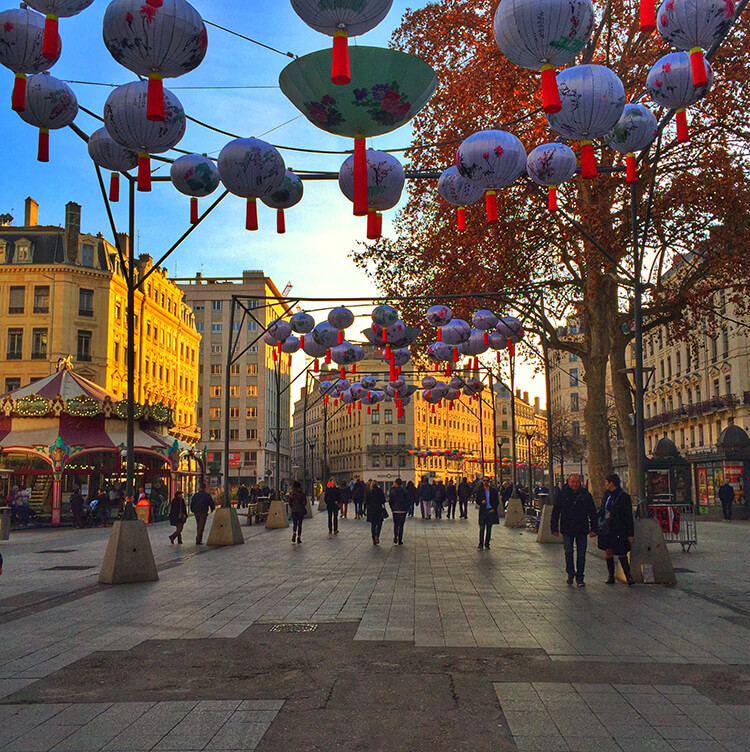
Of course, the main shopping street Rue de la République is home to the top fashion brands like Louis Vuitton, Dior and Hermès. Even in your wallet can’t handle a shopping spree, I always find the window displays are a show themselves. And if shopping isn’t at all your thing, Rue de la République is just a beautiful space to wander with 19th century buildings lining it, a glass carousel and benches for taking in the gorgeous public space.
Rue de la République leads in to La Place Bellecour, France’s third largest square. A statue of Statue of Louis XIV dominates the center of what was once called the Royal Square.
It’s so huge, you’ve really got to see it to grasp the size of the space. In summertime, the restaurants that line the square put tables outside. In winter, a Ferris wheel stands tall in the square gently lifting you up for a bird’s eye view over Lyon. And a variety of events like exhibitions and concerts take place throughout the year.
On completely the opposite end, the Presqu’île slopes upward to the La Croix-Rousse. It was known as the worker’s hill since its buildings housed the silk workers. But it has another secret – the Amphitheater of the Three Gauls is the lesser known of two Roman sites in Lyon (the other is on the Fourvière hill).
The Amphitheater of the Three Gauls dates back to 12 BC, so it’s much older than the Colosseum in Rome and predates the Romans arrival to present day France. Enlarged around 120 AD under Emperor Hadrian, it could hold around 20,000 people.
It was here that the first Christian martyrs of Gaul were tortured in 177 AD, the most famous who was St. Blandine. As the story goes, she was tied to a pole in the amphitheater and lions were released to kill and eat her, but the lions refused to come near Blandine. Clearly not doing their job, the lions were replaced by a bull who was meant to charge and gore Blandine…but the bull ignored her. Finally after enduring days of this torture, the soldiers took matters in to their own hands and killed her with a dagger.
The pole still stands in the amphitheater today as a memorial to the martyrs, including Blandine.
Climb the Croix-Rousse for Chokola!
Calling all the chocolate lovers for this one! I couldn’t resist dragging Tim up to the very top of the La Croix-Rousse hill to visit Chokola!, the flagship shop-cum-chocolate-laboratory created in the spirit of Charlie and the Chocolate Factory by French chocolatier Sébastien Bouillet. The trek was worth it and were indeed greeted by a milk chocolate waterfall tumbling down one of the walls of the shop.
On the wall opposite, my kind of library where chocolate bars made from chocolate around the world, were stacked like books at Barnes & Noble. We were the only ones in the shop on a quiet Sunday morning and the salesperson explained that these chocolates were representative of Sébastien’s love to travel. We can certainly understand that passion and ended up choosing a bar of dark chocolate from Tanzania out of the selection of over 40 different kinds.
The laboratory is where all sorts of unique things are made. It was around Christmastime when we popped in, so instead of the usual gingerbread houses Chokola!’s were made of chocolate. There was unique gifts like lipsticks, sunglasses and even a dress – all made of dark, milk and white chocolate, of course.
Eat at a Bouchon
No visit to France’s gastro capital is complete with dining at one of Lyon’s bouchons. Literally translating to tavern, a bouchon is a small restaurant and they were started to feel the workers who labored in the silk factories that made Lyon so prosperous.
Traditionally, bouchons were run by husbands and wives. The wife would cook the offals (a nice way of saying the internal organs like the liver of animals) family style in the kitchen, while the husband would work the dining room pouring Beaujolais wine for the patrons. The higher class would turn their nose up at these other bits of the butchered animals, but in those times you didn’t waste anything and they could be made in to a meal the silk workers could afford.
These days, the offals are considered a delicacy and can be quite expensive. Traditional bouchons still serve them to patrons with a more adventurous appetite. We decided to go a slightly safer route with another Lyonnaise dish – saucisson de Lyon with a borjealais wine sauce. It’s a sausage made of minced beef and bacon cooked in red wine. Simple and delicious, as the cuisine of Lyon’s bouchons was meant to be.
If you are up for a more adventurous meal, some traditional dishes you can try are chicken liver gâteau, calf’s sweetbreads (usually the stomach) or andouillette (a type of sausage made with pork, intestines and pepper, wine and seasonings). If none of that sounds like your thing, Lyon has more restaurants per capita than any other city in France so there’s bound to be a restaurant to please any palette.
This is a UNESCO World Heritage Site. For more info click here.
You can see all the UNESCO World Heritage Sites we’ve visited here.
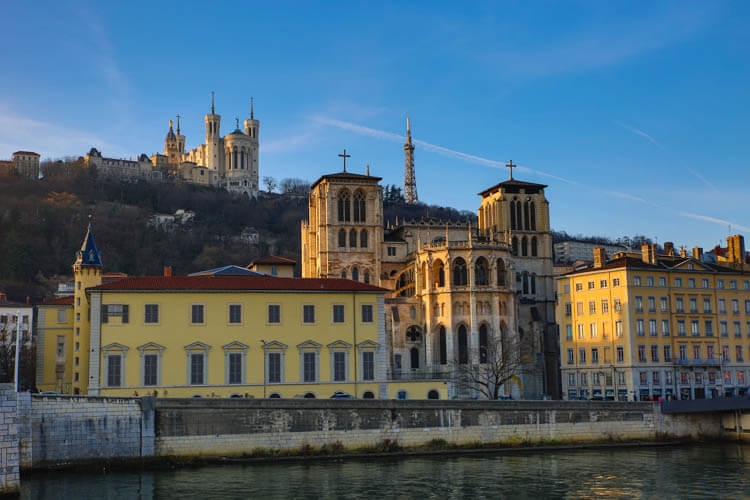


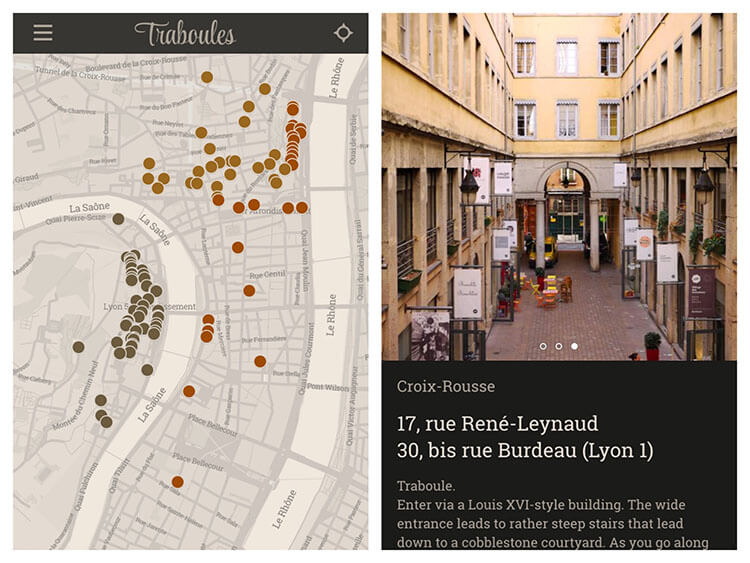
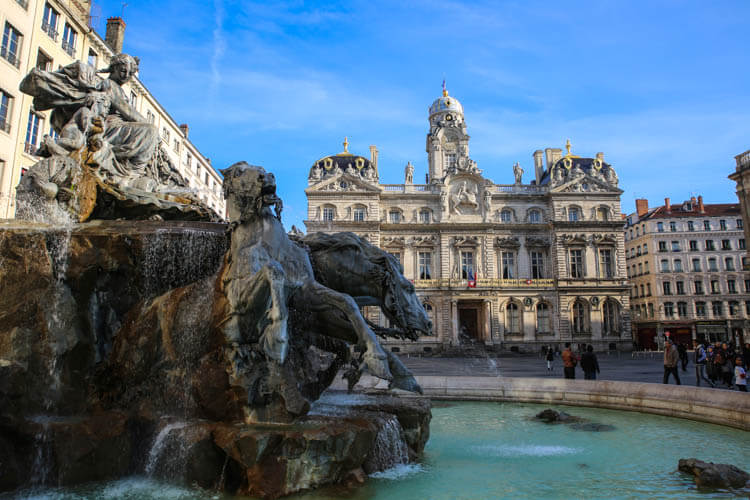
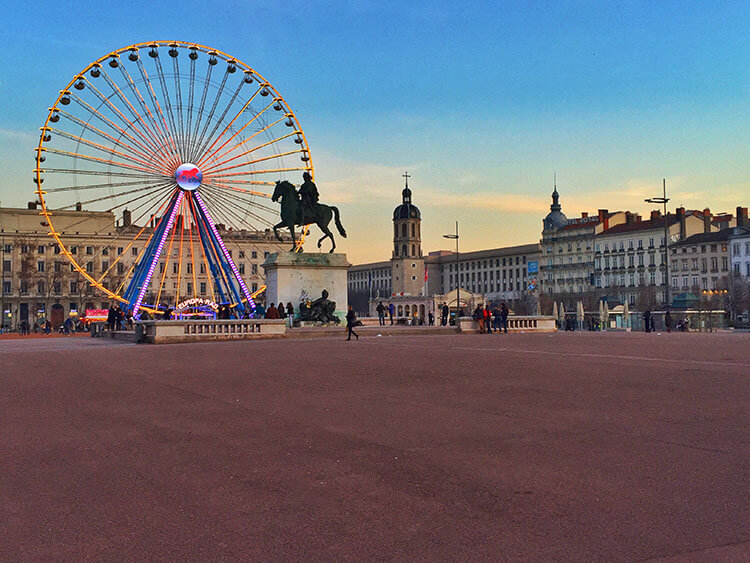


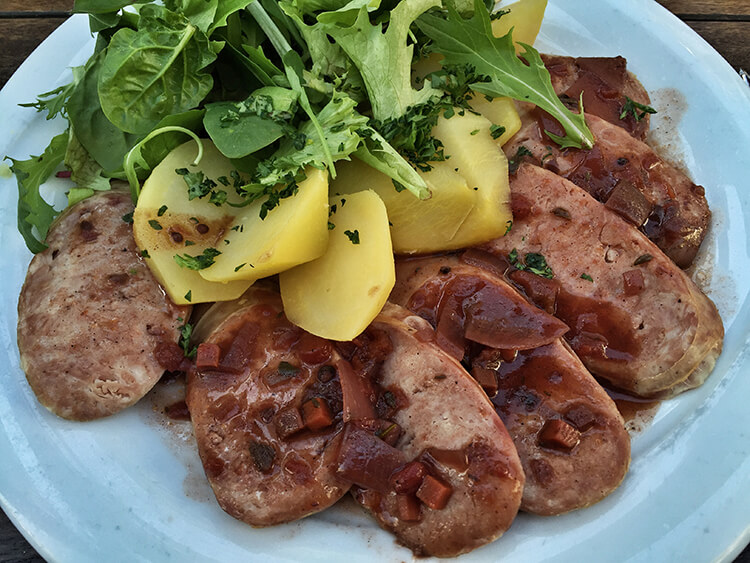

Marlene says
Very interesting and beautiful place to visit. Must make a stop for the chocolates
Jenn says
Loved the post and images, looks like you had a great time and are very well traveled!
Angela Street says
I love how you describe your adventures. The detail you provide really gives the reader a sense of actually being there. Lyon seems almost like a dreamy place. Thanks for all you share.
Christina says
Lyon is on my list already, but now it’s moved up a few notches!
Joanie says
What a fabulous place to visit. I love your pictures and definitely need to put the library of chocolate on our list of “must-see” places.
Monique says
WHOA, this all looks incredible! Chokola is calling to me!
Deborah says
What a gorgeous place! I love all of the history and architecture. And of course, the food!!
annie chaboisseau says
First time to be in Lyon this coming weekend and will stay for 3 days before going to Nice. Thanks for all the tips, I guess we won’t be bored stayin gthis beautiful city